AUDI TT ROADSTER 2011 Repair Manual
Manufacturer: AUDI, Model Year: 2011, Model line: TT ROADSTER, Model: AUDI TT ROADSTER 2011Pages: 260, PDF Size: 64.11 MB
Page 61 of 260

automatic dimming of the o uts ide m ir
r or s will likewise be di sabled .
-Check to make sure there are no objects
preventing light from reaching the inside
mirror.
- Do not attach any sticke rs to the wind
shield in front of the two light sensors,
as this would interfere with both the au
tomatic operation of the headlights and
the automatic dimming of the inside mir ror(s).
Outside mirrors
The outside mirrors ore electrically adjusted.
Fig. 67 Forward section of drive r's armrest: power mir
ror contro ls
Adju sting th e outside mirror s
• Turn the adjusting knob to posit ion ©
Q fig. 67 to adjust the o utside mirror on the
driver's side .
• Turn the adjusting knob to position ® to ad
just the outside mirror on the passenger
side.
• Press the knob in the appropriate direction
to move the mirror surface so that you have
a good view to the rear.
Heated mirro rs
• Turn the knob to posit ion @.
Depending on the outside temperature, the
mirror surfaces are heated until the ignition is
switched off -even if the knob is no longer in
position @. You are well-advised to fold the
outs ide mirrors in when maneuvering in tight
spaces or when leaving the car parked close to
other veh icles.
Clear vi sion 59
(D Note
- Curved ( i.e. convex) mirror s urfaces in
crease yo ur field of view. Remember that
vehicles or other objects will appear
smaller and farther away than when
seen in a flat m irror . If you use this mir
ror to estimate distances of following ve
hicles when chang ing lanes, you could
es timate incorrectly and cause an ac ci
dent.
- If the mirror housing is moved uninten
tionally (for examp le, w hile pa rking your
vehicle), then yo u must first fold the m ir
ror elect rically . Do not rea djust the mir
ror housing man ually . You cou ld damage
the motor which controls the mirror .
(D Tips
If there sho uld be a ma lf u nction in the
e lectrica l system, yo u can sti ll adjust the
outside m irrors by pressing the edge of
the m irror.
Automatic dimming for outside mirrors
Applies to vehicles: wit h automatic dimm ing for outside
mirro rs
The outs ide mirrors are dimmed together with
the automatic dimming of the inside mirror .
When the ignition is sw itched on, the mirrors
darken automatically depending on the light
striking them (e .g. headlights from the rear) .
When the interior lighting is switched on and
when reverse gear is engaged, the mirrors are
switched back to the ir original br ightness (not
dimmed) .
A WARNING
Broken glass of automat ic dimming mirror
can cause electrolyte flu id leakage. El ec
trolyte f lu id can ir rit a te skin, eyes, a nd res
p ira to ry system.
- Repeated or prolonged exposu re to e lec
trolyte can cause irritation to the respira
tory sys tem, espe cially among people
wit h asthma or other resp irato ry co ndi -
tions . Get fresh air immediately by
~
Page 62 of 260
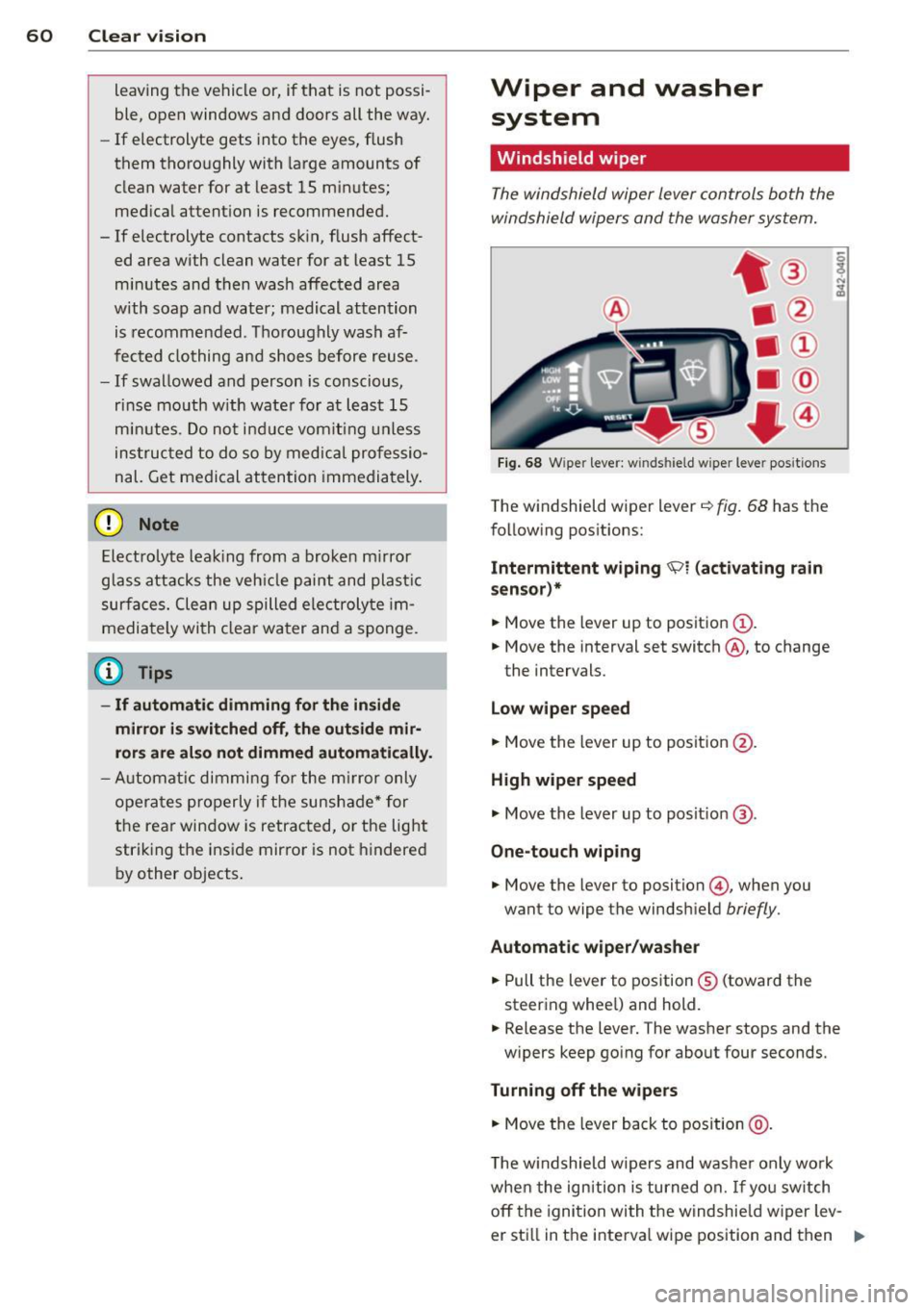
60 Clear vis ion
leaving the vehicle or, if that is not possi
ble, open windows and doors all the way.
- If electrolyte gets into the eyes, flush
them thoro ughly with large amounts of
clean water for at least 15 m inutes;
med ica l attent ion is recommended.
- If electrolyte contacts sk in, f lush affect
ed area with clean water for at least 15
minutes and then was h affected area
with soap and water; medical attention is recommended. Thoroughly wash af
fected clothing and shoes before reuse.
- If swallowed and person is conscious,
rinse mo uth w ith water for at least 15
m in utes . Do not i ndu ce vom iting u nless
ins truc ted to do so by medica l professio
nal. Get medical attention immedia tely.
(D Note
Electrolyte leak ing from a broken m irror
glass attacks the veh icle paint and plast ic
surfa ces. Clean up spilled electroly te im
mediately wi th clear water and a sponge.
@ Tips
- If automatic dimming for the in sid e
mirror i s switched off, the outside m ir
rors are al so not dimmed automaticall y.
- Automa tic dimming for the m irror only
opera tes p roperly i f the sunshade * for
the rear window is retracted, o r the light
striking the ins ide mir ro r is not hindered
by other objects .
Wiper and washer
system
Windshield wiper
The windshield wiper lever controls both the
windshield wipers and the washer system.
F ig . 68 W ipe r leve r: w inds hield w ipe r leve r posit ions
T he windshield wiper lever~ fig. 68 has the
following pos itions:
Intermittent w iping \91 (activating r ain
sens or)*
.,. Move the lever up to position (!) .
.,. Move the interval set switch @, to change
the intervals.
Low wiper spe ed
.,. Move the lever up to posit ion @.
High w iper speed
.,. Move the lever up to posit ion ®·
One-touch wiping
.,. Move the lever to position @ , when you
want to wipe the windshield
briefly.
Automatic wiper /wa sher
.,. Pull the lever to position ® (toward the
steering whee l) and hold .
.,. Release the lever. The washer stops and the
w ipers keep go ing for about four seconds.
Turning off the wipers
.,. Move the lever back to position @ .
The w indshield wipers and washer only wo rk
whe n the ign ition is turned on.
If you sw itch
off the ignition with the windshie ld w iper lev-
er sti ll in the interva l wipe position and then
Ill>
Page 63 of 260

come back a while later and drive off, the rain
sensor will reactivate itself after the vehicle
speed has exceeded 4 mph (6 km/h).
The rain sensor* is only activated with the
wiper lever set to position(!). When it starts
to rain, the rain sensor will automatically acti
vate the intermittent wiping mode.
To reduce the sensitivity of the sensor, move
switch @ down. To increase the sensitivity,
move the switch up. The higher you adjust the
sensitivity, the faster the sensor will react
when it senses moisture on the windshield. The pauses between wiper turns depend not
only on the sensitivity setting, but on the ve
hicle speed as well.
During brief stops, e.g . at a red light, wiper
motion will automatically be reduced to the
next lower speed . Wipers already turning at
low speed. change to intermittent wiping.
When the ignition is turned on, the washer
jets are heated .
A WARNING
-Wiper blades are crucial for safe driving!
Only when they are in good condition are
they able to clear the windows properly
to provide uncompromising visibility.
Worn or damaged wiper blades are a
safety hazard ¢
page 63, Replacing
windshield wiper blades!
- The light/rain sensor* is only designed to
assist and support the driver.
It remains
entirely the driver's responsibility to
monitor outside weather conditions and
to manually activate the wipers as soon
as rain or drizzle reduces visibility
through the windshield.
- The windshield must not be treated with
water-repellent materials. They can in
crease glare under poor visibility condi
tions such as wetness, darkness, or when
the sun is low on the horizon. In addi
tion, they can cause the windshield wip
ers to chatter.
Clear vision 61
@ Note
In freezing or near freezing conditions:
- Always check that the wiper blades are
not frozen to the glass before you turn
the wipers on. Loosen a wiper blade
which is frozen in place before operating
the wipers to prevent damage to the
wiper blade or the wiper motor.
- Do not use the wipers to clear a frosted
window. Using the wipers as a conven ient ice scraper will destroy the wiper
blades .
- Before you take your vehicle to an auto
matic car wash, make sure you have the
windshield wiper system switched off (lever in position
0), otherwise the wind
shield wiper system could get damaged
in the car wash if it should suddenly
come on.
@ Tips
-The windshield wipers are switched off
when the ignition is turned off. Activate
the windshield wipers after the ignition
is switched back on by moving the wind
shield wiper lever to any position.
- Worn or dirty windshield wiper blades
cause smearing, which can affect the op
eration of the light/rain sensor*. Check
the condition of your windshield wiper
blades regularly.
-The rain sensor is part of the interval
wiping system. Turning off the ignition
will also deactivate the rain sensor. To re
activate the sensor, switch off the inter
val wiping function, then switch it back
on again.
-Applies to vehicles with light/rain sen
sor: When the wipers are switched on
manually and in rain conditions, the au
tomatic headlights* turn on¢
page 53,
Switching the headlights on and off
or
off during the day when the wipers are
no longer operating. The automatic
headlights* function is available in this
case only when the light switch is in the
"AUTO" position¢
page 53, fig. 57.
Page 64 of 260
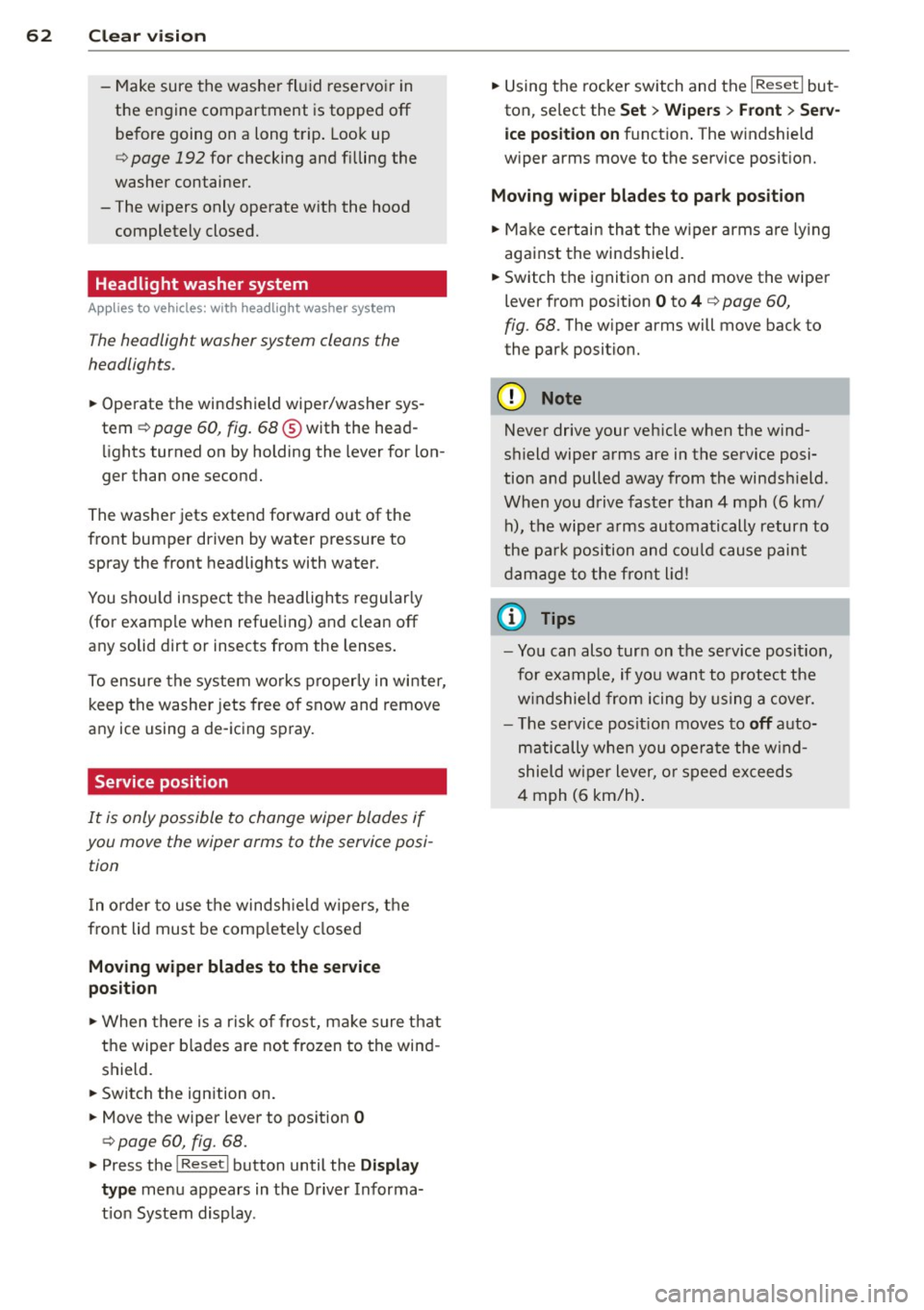
62 Clear vis ion
- Make sure the washer fl uid reservoir in
the engine compartment is topped
off
before going on a long trip . Look up
c:> page 192 for checking and fi lling the
washer container.
- The w ipers only operate w ith the hood
completely closed.
Headlight washer system
App lies to vehicles: with hea dlig ht washer system
The headlight washer system cleans the
headlights.
.. Operate the winds hield wiper/washer sys
tem
c:> page 60, fig. 68 ® with the head
li ghts turned on by holding the lever for lon
ger than one second.
The washer jets extend forward o ut of the
front bumper driven by water pressure to
spray the front headlights with water.
You shou ld inspect the headlights regularly
(for example when refue ling) and clean
off
any solid dirt or insects from the lenses .
To ensure the system works properly in winter,
keep the washer jets free of snow and remove
any ice using a de-icing spray.
Service position
It is only possible to change wiper blades if
you move the wiper arms to the service posi
tion
I n o rder to use the windsh ie ld w ipers, the
front lid must be comp letely closed
Moving wiper blades to the service
position
.. When there is a ris k of frost, ma ke s ure that
the wiper b lades are not frozen to the wind
shield .
.. Switch the ignition on .
.. Move the wiper lever to pos ition
0
c:> page 60, fig. 68 .
.. Press the I Reset I button until the Display
type menu appears in the Driver Informa
t ion System display . ..
Using the rocker switch and the
I R ese t I but
ton, se lect the Set > Wipe rs > Front > Se rv
ice po sition on function . The w indshield
w iper arms move to the service posit ion.
Mo ving wip er blades to pa rk position
.. Make certain that the w iper arms are ly ing
against the windshield .
.. Switch the ignition on and move the wipe r
lever from pos ition O
to 4 c:> page 60,
fig. 68.
The w iper arms will move back to
the park position.
@ Note
Never drive your veh icle when the wind
sh ield wiper arms are in the service posi
tion and pulled away from the winds hield.
When you d rive faster than 4 mph (6 km/
h), the wiper a rms automatically return to
the pa rk position and cou ld cause paint
d amage to the front l id!
@ Tips
= Yo u can also tur n on the se rvice posit ion,
for example, if yo u want to p rotect the
w indshield from icing by us ing a cover.
- The service posit ion moves to
off a uto
matically whe n you ope ra te the w ind
shield wiper lever, o r speed exceeds
4 mph (6 km/h) .
Page 65 of 260
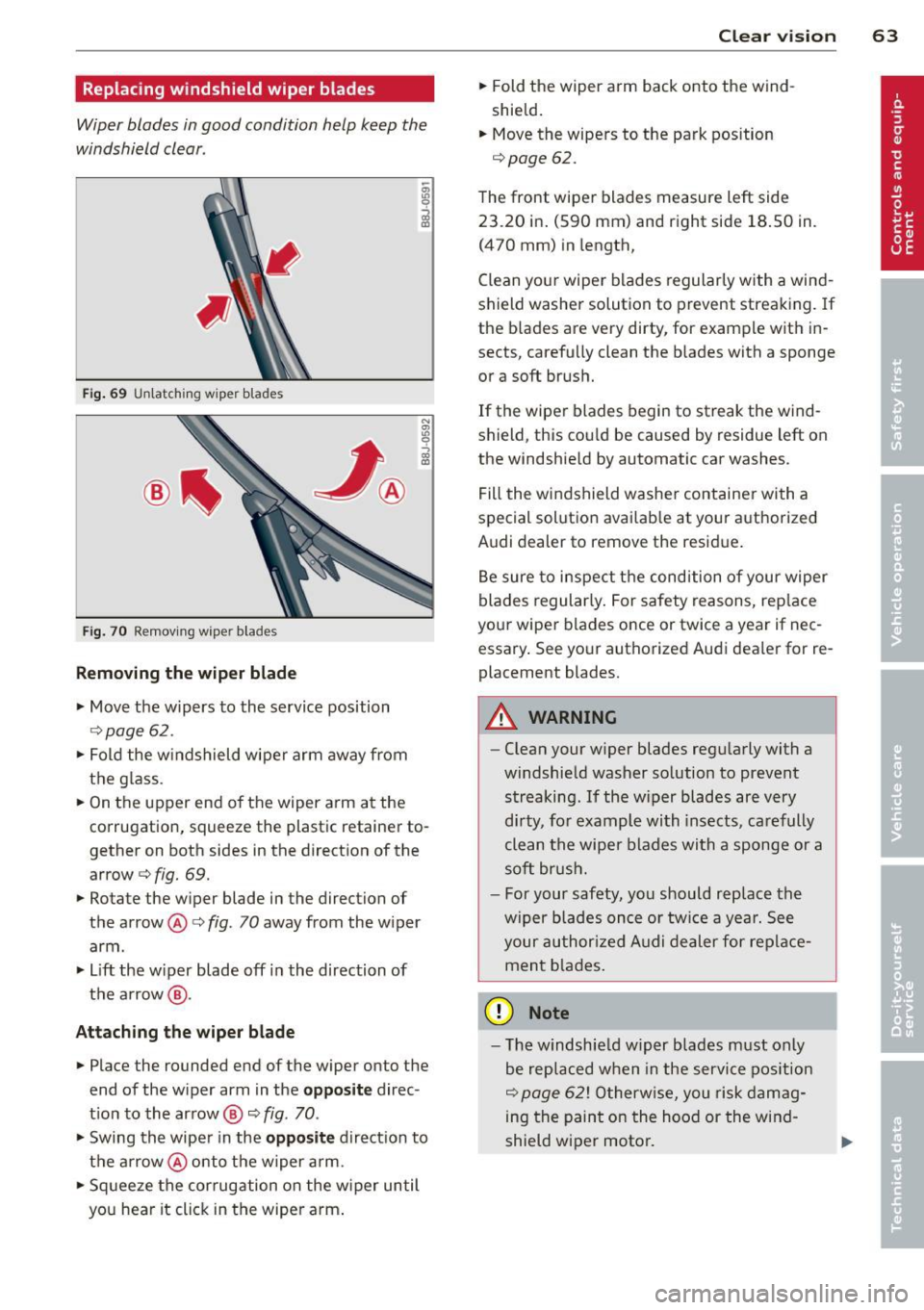
Replacing windshield wiper blades
Wiper blades in good condition help keep the
windshield clear .
Fig. 69 U n latc hing wiper blades
Fi g. 7 0 Remov ing wiper b lades
Removing the wip er blade
• Move the wipers to the service position
c::> page 62.
• Fold the w indshield wiper arm away from
the g lass.
• On the upper end of t he wiper a rm at the
corrugation, squeeze the plastic retainer to
gether on both sides in the direction of the
arrow c::>
fig. 69.
• Rotate the w iper blade in the direction of
the arrow @c::>
fig. 70 away from the w iper
arm .
• Lift the w iper blade off in the direction of
t h e a rrow @.
Attaching the wiper blade • Place the rounded end of the wiper onto the
end of the w iper arm in the
opposite direc
t ion to the arrow @ c::>
fig. 70.
• Swing the wiper in the
opposite directio n to
t h e a rrow @onto the wiper arm.
• Sq ueeze the cor rugation on the w iper until
you hear it cl ick in the wipe r arm .
Clear vi sion 63
• Fold the wiper arm back onto the wind
shield .
• Move the wipers to the park position
c::>
page 62.
The front wipe r blades measure left side
23.20 in . (590 mm) and right side 18 .50 in.
(470 mm) in length,
C lean you r wipe r blades regularly with a wind
shield washer solution to prevent streaking. If
t h e b lades are very dirty, for examp le with in
sects, caref ully clean the b lades with a sponge
or a soft brus h.
If the wiper blades begin to streak the wind
shield, this co uld be caused by residue left on
the windshie ld by automatic car washes.
Fill the wi ndshield washe r containe r with a
spec ial solut io n avai lab le at your a uth orized
A udi dealer to remove the resid ue .
Be sure to inspect t he condition of your wiper
blades regula rly. F or safety reasons, rep lace
yo ur wiper blades o nce or twice a year if nec
essary . See yo ur authorized Aud i dealer for re
placement blades.
A WARNING
- Clean your w iper blades regu larly with a
windshie ld washer so lution to prevent
streaking. If the w iper blades are very
d irty, fo r example wi th insects, ca refully
clean the wiper blades with a sponge or a
so ft br ush.
- For your safe ty, yo u should r ep lace the
w iper b lades once o r twice a year . See
your author ized A udi de aler for repla ce
men t blad es.
(D Note
- The windshie ld wiper blades m ust only
be replaced when in the service pos ition
c::> page 62! Otherw ise, you risk dam ag
ing the pain t on the hood or the w ind
shield w iper moto r.
Page 66 of 260
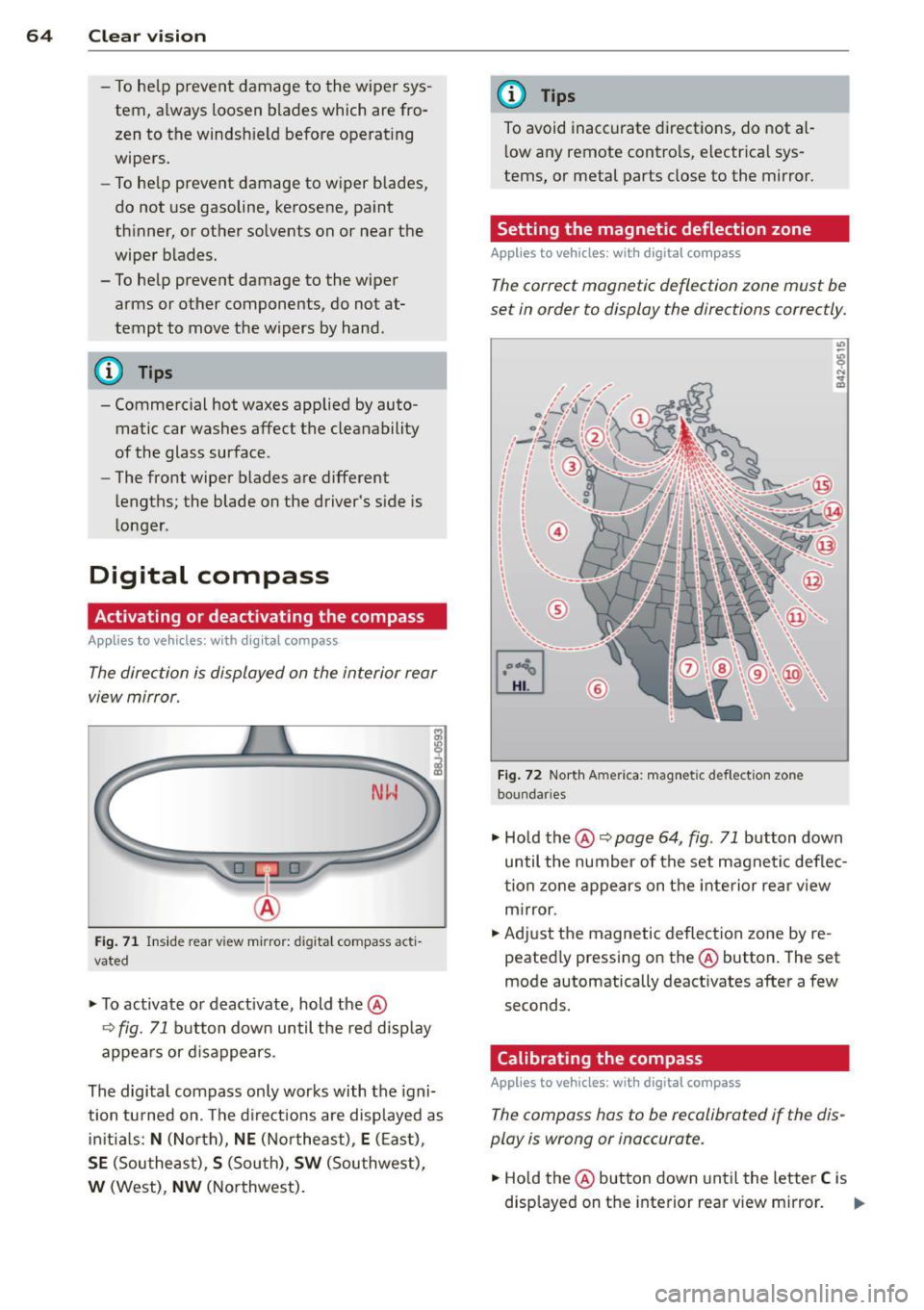
64 Clear vis ion
- To he lp prevent damage to the wiper sys
tem, a lways loosen blades which are fro
z en to the windsh ie ld before operat ing
wipers.
- To he lp prevent damage to w iper blades,
do not use gasoline , kerosene, pa int
thinner, or other solvents on or near t he
wiper blades .
- To he lp prevent damage to the wiper
arms or other comp onents, do not at
tempt to move the wipers by hand .
(D Tips
-Commercial hot waxes applied by auto
matic car washes affect the cleanability
of the glass surface .
- The front wipe r blades are different
l engths; the blade on the driver's s ide is
l onger .
Digital compass
Activating or deactivating the compass
Applies to vehicles: with digital compass
The direction is displayed on the interior rear
view mirror.
Fi g. 71 In side rea r view m irro r: di gita l compass acti
vated
.. To activate o r deact ivate, hold the@
¢ fig. 71 button down until the re d disp lay
appe ars or d is a ppears.
The digital compass only works with the igni
tion tu rned on . Th e d irect io ns are displayed as
ini tial s:
N (Nor th), NE (N ort he ast), E (E as t),
SE (Southe ast), S (Sou th), SW (Sou thwest),
W (West), NW (No rthwest).
(D Tips
To avoid inacc urate dir ections, do not a l
l ow any remote contro ls, electr ica l sys
tems , or metal parts close to the mirror.
Setting the magnetic deflection zone
Appl ies to vehicles: with digita l compass
The correct magnetic deflection zone must be
set in order to display the directions correctly.
©
Fi g. 72 Nort h Am eric a: mag neti c def le ction zone
bo un dar ies
" Ho ld the @ ~ page 64, fig . 71 button down
until the number of the set magne tic deflec
t ion zo ne appe ars on t he inte rior re ar v iew
m irror.
.. Adjust the magnetic deflec tion zone by re
peated ly pressing on the @button . The set
mode automatically deact ivates afte r a few
seconds.
Calibrating the compass
Applies to vehicles: with digita l compass
The compass hos to be recalibrated if the dis
play is wrong or inaccurate.
.. Ho ld the @button down until the letter C is
disp layed on t he interior rear v iew mirror. ..,.
Page 67 of 260
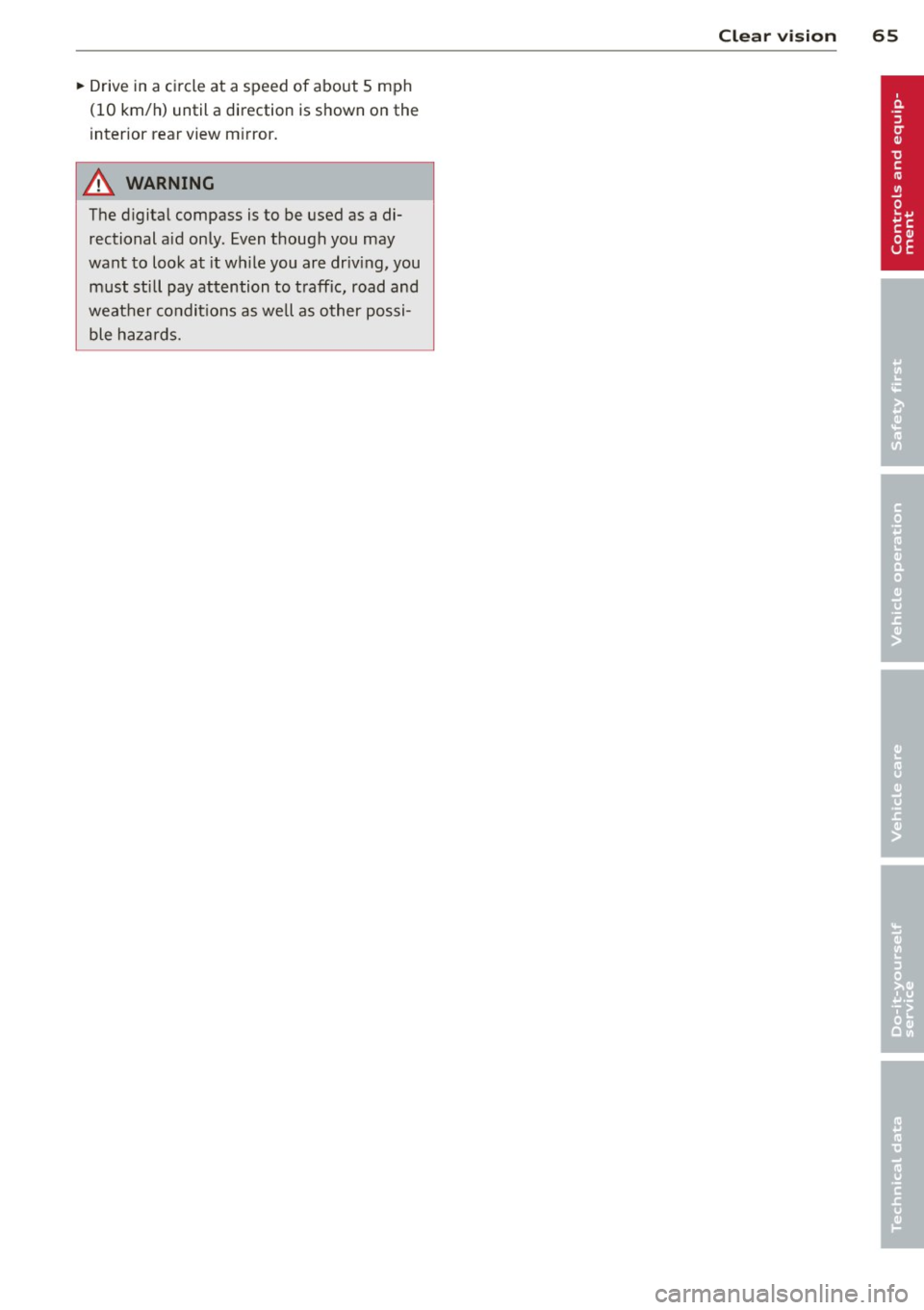
~ Drive in a circle at a speed of about 5 mph
(10 km/h) until a direction is shown on the
interior rear view mirror.
A WARNING
The d igital compass is to be used as a di
rectional a id only. Even though you may
want to look at it wh ile you are driv ing, you
must sti ll pay attention to t raffic, road and
weather condit ions as we ll as other possi
ble hazards.
Clear vis ion 65
Page 68 of 260
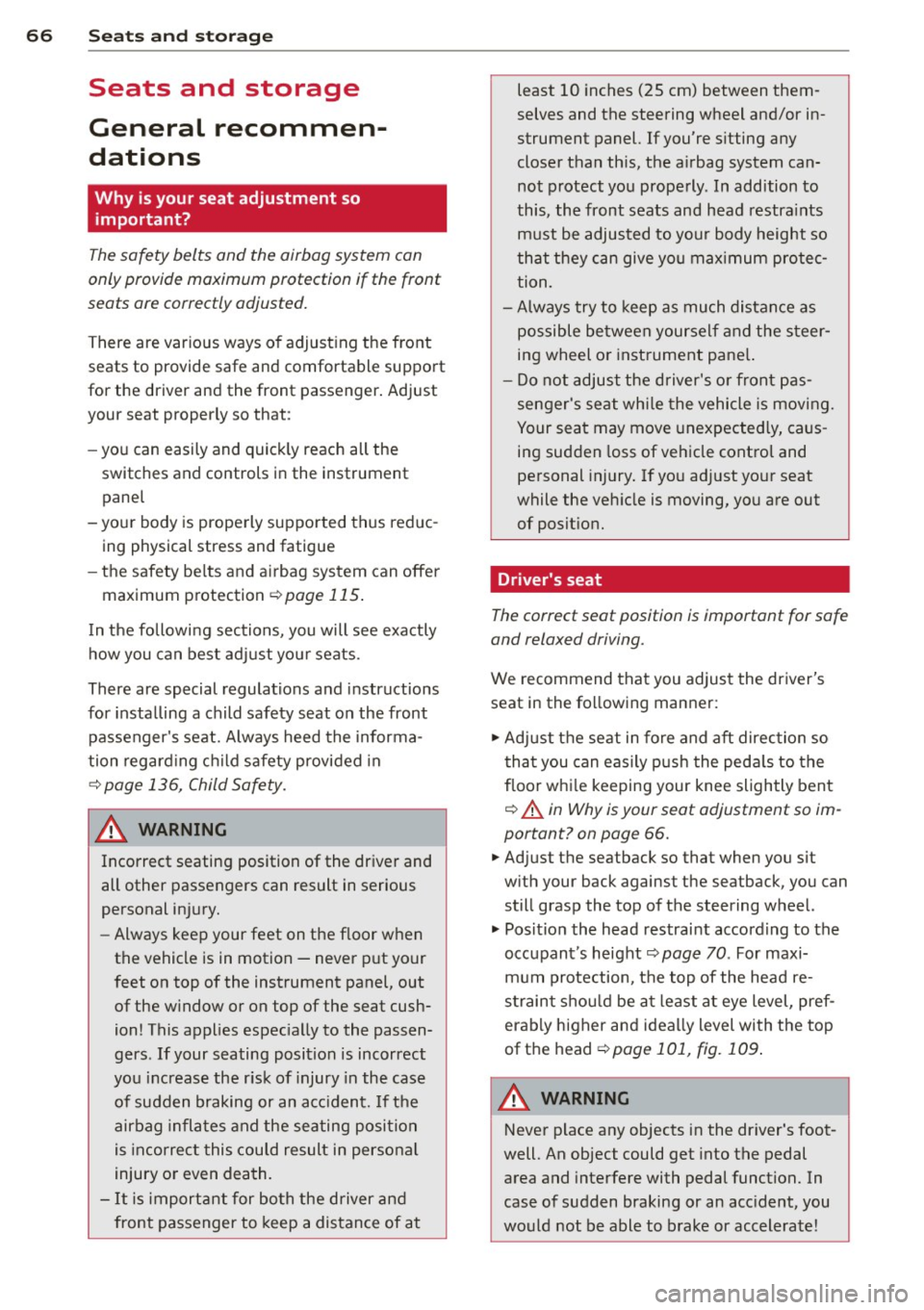
66 Seat s a nd s tor ag e
Seats and storage
General recommen
dations
Why is your seat adjustment so
important?
The safety belts and the airbag system can
only provide maximum protection if the front
seats are correctly adjusted.
There are various ways of adjust ing the front
seats to provide safe and comfortable support
for the driver and the front passenger . Adjust
your seat properly so that :
- you can easily and quick ly reach all the
switches and controls in the instrument
panel
-your body is prope rly supported thus reduc
ing physical stress and fatigue
- the safety be lts and airbag system can offe r
maximum protection
¢ page 115 .
In the following sec tions, you will see exactly
how you can best adjust you r seats .
There are special regulations and instructions
for insta lling a child safety seat on the front
passenger's seat. Always heed the informa
tion rega rd ing child safety provided in
¢ page 136, Child Safety .
A WARNING
Incorrect seating position of the driver and
all other passengers can result in serious
personal injury.
- Always keep your feet on the floor when
the vehicle is in motion -never p ut your
feet on top of the instrument panel, out
of the w indow or on top of the seat cush
ion! This applies espec ially to the passen
gers .
If your seating position is incorrect
you increase the r isk of injury in the case
of sudden braking or an acc ident.
If the
airbag infla tes and the seating position
is incorrect this could result in personal
injury or even death.
- It is import ant for bo th the driver and
front passenger to keep a distance of at least 10 inches (25 cm) between them
selves and the steering wheel and/or in
strument panel. If you're s itting any
closer than th is, the a irbag system can
not protect you properly . In addition to
this, the front seats and head restra ints
must be adjusted to your body height so
that they can give you max imum protec
tion.
- Always try to keep as much distance as
possible between yourself and the s teer
ing wheel or instrument pane l.
- Do not adjust the driver's o r fron t pa s
senger's seat whi le the vehicle is moving.
Your seat may move unexpected ly, caus
ing sudden loss of vehicle contro l and
personal injury . If you ad just yo ur seat
while the veh icle is moving, you are out
of posit ion.
Driver's seat
The correct seat position is important for safe
and relaxed driving.
We recommend that you adjust the driver's
seat in the fo llowing manner:
.,. Adjust the seat in fo re and aft direction so
t ha t you can easily p ush the peda ls to the
floor wh ile keeping your knee slightly bent
i::> A in Why is your seat adjustment so im
portant? on page
66 .
.,. Adjust the seatback so that when you sit
w ith your back against the seatback, you can
still grasp the top of the steering wheel.
.,. Posit io n the head restraint according to the
occupant 's height
<=:>page 70 . For maxi
mum protection, t he top of the head re
s t raint shou ld be a t least at eye level, pref
erab ly higher and idea lly level with the top
of the head
¢ page 101, fig. 109 .
A WARNING "--
Never place any objects in the dr iver's foot-
well. An object could get into the pedal
area and interfere with pedal function. In
case of sudden braking or an acc ident, you
wo uld not be able to brake or accelerate!
Page 69 of 260
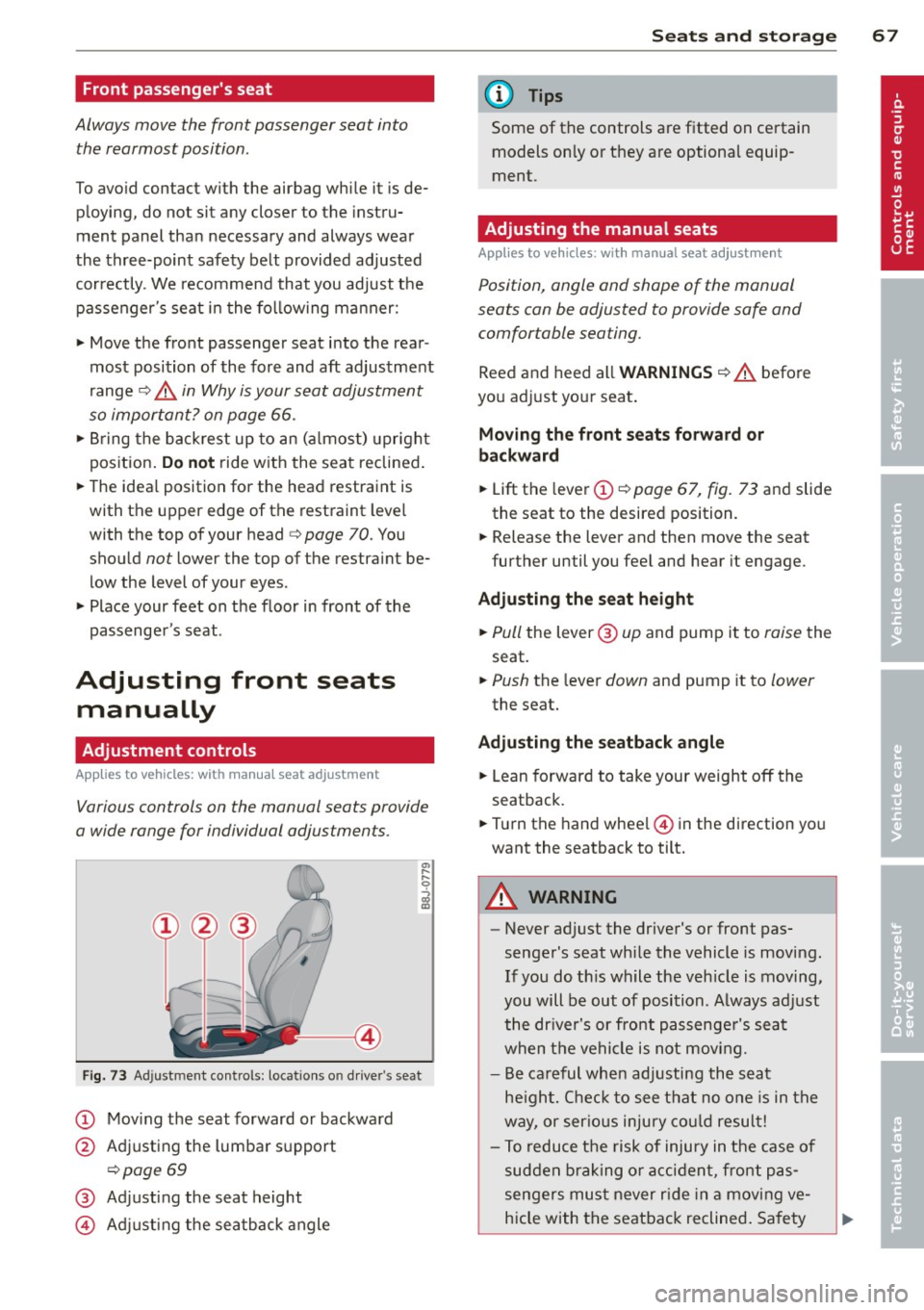
Front passenger's seat
Always move the front passenger seat into the rearmost position .
To avoid contact with the airbag while it is de
p loying, do not sit any closer to the instru
ment panel than necessary and always wear
the three-point safety belt provided adjusted
correctly . We recommend that you adjust the
passenger's seat in the following manner:
.,. Move the front passenger seat into the rear
most position of the fore and aft adjustment
range
c:::> &. in Why is your seat adjustment
so important? on page
66.
.,. Bring the backrest up to an (almost) upright
position.
Do not ride with the seat reclined .
.,. The idea l position for the head restraint is
with the upper edge of the restraint leve l
with the top of your head
c:::> page 70. You
shou ld
not lower the top of the restra int be
low the level of your eyes .
.,. Place your feet on the floor in front of the
passenge r's seat .
Adjusting front seats
manually
Adjustment controls
App lies to vehicles: with manual seat adjustment
Various controls on the manual seats provide
a wide range for individual adjustments .
Fig. 73 Adjustment contro ls: loca tions o n dr iver's seat
CD Moving the seat forward or backward
@ Adjusting the lumbar support
c:::> page 69
@ Adjusting the seat height
© Adjusting the seatback angle
Seats and storage 67
(D Tips
Some of the controls are fitted on certain
models on ly or they are optional equip
ment .
Adjusting the manual seats
Applies to vehicles : wit h manual seat adjustment
Position, angle and shape of the manual
seats can be adjusted to provide safe and
comfortable seating .
Reed and heed all WARNINGS c:::> A before
you adjust your seat .
Moving the front seats forward or
backward
... Lift the lever CD c:::> page 67, fig. 73 and slide
the seat to the desired position.
.,. Release the lever and then move the seat
further until you feel and hear it engage.
Adjusting the seat height
.,. Pull the lever @ up and pump it to raise the
seat.
... Push the lever down and pump it to lower
the seat.
Adjusting the seatback angle
.,. Lean forward to take your weight off the
seatback.
... Turn the hand wheel © in the direction yo u
want the seatback to tilt.
A WARNING
-
- Never adjust the driver's or front pas
senger's seat whi le the vehicle is moving.
If you do th is while the vehicle is moving,
you will be out of position. Always adjust
the driver's or front passenger's seat
when the vehicle is not moving.
- Be careful when adjusting the seat
height. Check to see that no one is in the
way, or serious injury could result!
- To reduce the risk of injury in the case of
sudden braking or accident, front pas
sengers must never rid e in a moving ve
hicle with the seatback reclined . Safety
Page 70 of 260
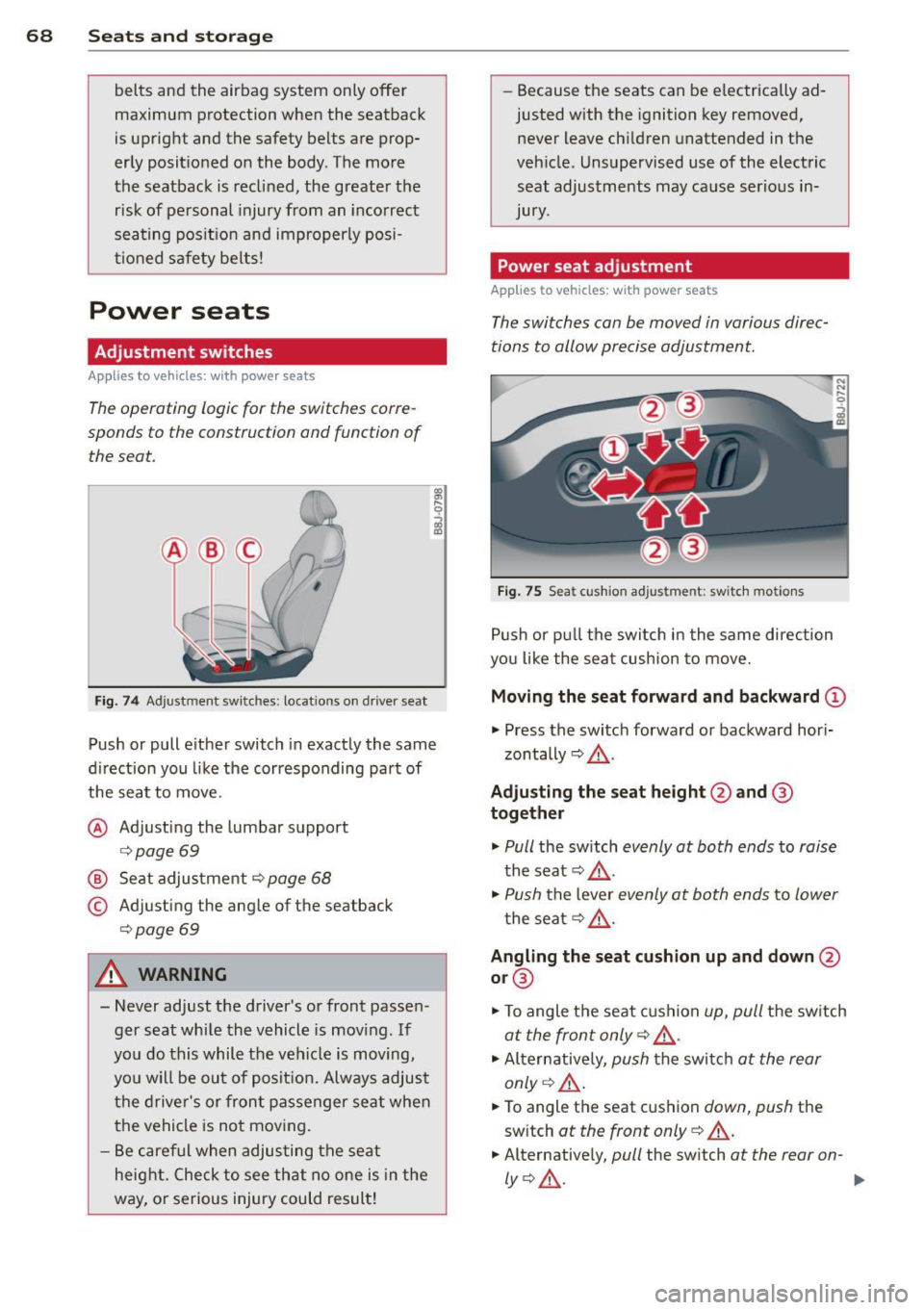
68 Seats and st o ra ge
belts and the airbag system only offe r
maximum protection when the seat back
is u pright and the safety belts are prop
erly positioned on the body . The more
the seatback is reclined, the greater the
risk of personal injury from an incorrect
seating pos it ion and improperly posi
t ioned s afety be lts!
Power seats
Adjustment switches
App lies to vehicles: with power seats
The operating logic for the switches corre
sponds to the construction and function of
the seat.
F ig . 7 4 Adju stm en t sw it c h es: locat io ns o n dr ive r seat
Push or pull e ither switch in exactly the same
d irection you like the corresponding part of
the seat to move.
@ Adjusting the lumba r support
¢ page 69
@ Seat adjus tment¢ page 68
© Adjusting the ang le of the seatback
¢ page 69
A WARNING
- Never adjust t he d river's o r front passe n
ger seat wh ile the vehicle is moving . If
yo u do this while t he veh icle is moving,
yo u will be ou t of posi tion. Always adjust
t h e dr ive r's or front passenger se at when
the vehicle is not mov ing.
- B e caref ul when adju sting t he seat
heig ht. Check to see that no one is in the
way, or serious injury could result! -
Because the seats can be e lectrically ad
justed with the ignition key removed,
never leave chi ldren unattended in the
veh icle . Unsupervised use of the electric
seat adjustments may ca use serio us in
Jury .
Power seat adjustment
Applies to vehicles: wit h power seats
The switches can be moved in various direc
tions to allow precise adjustment.
Fig. 75 Sea t cus hion ad ju st me nt: s wit c h m oti on s
P ush or p ull the switch i n the same direction
yo u like the sea t cushion to move.
Moving the seat forward and backward ©
.., Press the switc h forward or backward hor i-
zontally ¢& .
Adju sting the seat height@and @
together
.., Pull the sw itch evenly at both ends t o raise
the seat ¢ A.
.., Push the lever evenly at both ends to lower
t he sea t¢ & -
Angling the seat cushion up and down@
or @
.., To angle t he seat cushion up, pull the sw itch
at the fron t only ¢& .
.., Altern ative ly, push the switc h at the rear
only ¢& .
.., To angle the seat c ushion down, push the
sw itch
at the front only¢ A.
.., Alternative ly, pull the sw itch at the rear on-
ly ¢& . ....